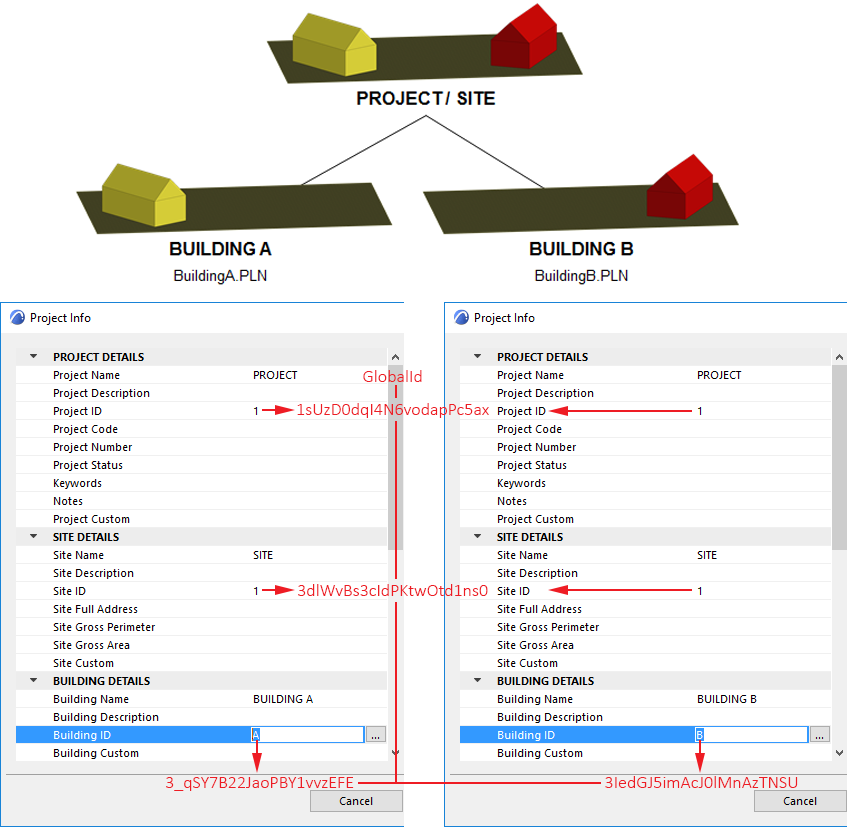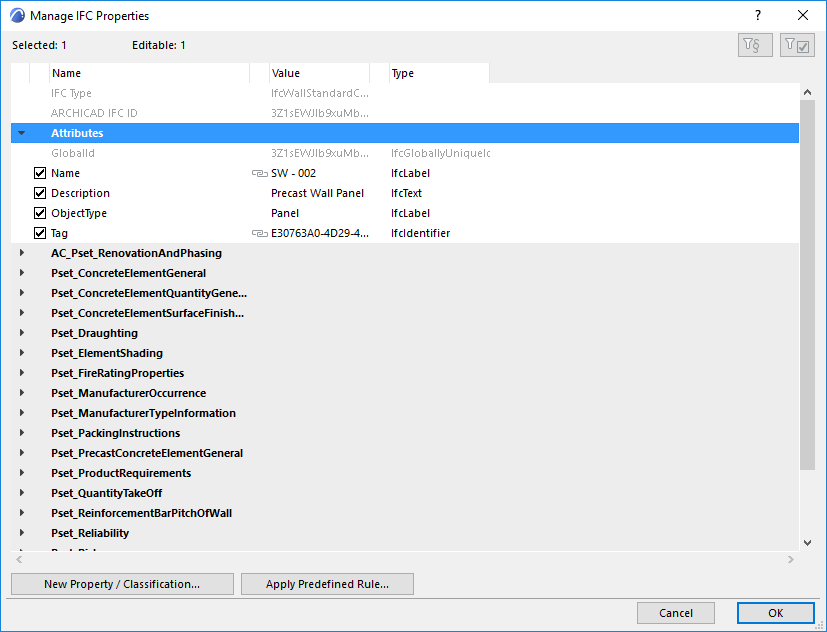
This chapter summarizes the main IFC data types available in ARCHICAD.
In an IFC model, the project information (generated, for example, from an ARCHICAD project) is represented as a set of IFC Entities - such as IFC Type, Attribute, Assignment, Type Product. Each IFC Entity (for example, an IfcWall) includes a fixed number of IFC Attributes, plus any number of additional IFC Properties.
Some IFC Entities express characteristics of other entities. Some of these correspond to ARCHICAD attributes. These correspondences are mapped automatically when the IFC model is generated or exported, or when the IFC model is imported.
|
ARCHICAD Attribute |
IFC Entity |
|
Layer |
IfcPresentationLayerAssignment |
|
Building Material |
IfcMaterial |
|
Surface |
IfcSurfaceStyleRendering |
|
Composite |
IfcMaterialLayerSet (extruded geometry) or IfcMaterialList (BREP geometry) |
|
Profile |
IfcProfileDef |
You can set different preferences for converting Layers, Building Materials and Surfaces of imported IFC models: use the conversion settings of Import translators.
See Layer Conversion for IFC Import and Material and Surface Conversion.
An IFC model is composed of IFC Entities built up in a hierarchical order. As shown in the following illustration, each story level (IfcBuildingStorey) has its corresponding story in ARCHICAD.

In ARCHICAD, all elements and objects are linked to a home story. Thus, by default, the IFC model hierarchy lists them under the IfcBuildingStorey of the same name as the elements’ home story. However, in IFC Project Manager, elements can be assigned directly to the IfcSite or IfcBuilding. So, for example, neighboring buildings (e.g. defined by the Morph tool) and site context elements (trees, fences, roads, etc.) can be assigned to the site instead of the project building with its story system.
By default, the IFC elements (for example the IfcBuildingElements) and the IfcSpace entities are on the same hierarchy level in an IFC model. However, ARCHICAD Objects and Morphs - regardless of their Classification - can be displayed on and, for IFC export purposes, linked to the ARCHICAD Zone (IfcSpace) that contains them, instead of to their home story.
IFC Spatial Elements
IFC Spatial Elements are IfcProject, IfcSite, IfcBuilding, IfcBuildingStorey, as well as IfcSpace. They are at the top of the IFC Project Manager Hierarchy.
These elements can only be managed through the IFC Project Manager, where you can also edit their IFC-related data.
The IFC Attribute values of these spatial elements, however, are derived from the data of the current ARCHICAD project.
IfcSite is the geographic position of the IfcProject. It can have a geometry, but a geometry is not required. In ARCHICAD, site geometry is represented by Mesh elements, Site-type Objects, or elements with “Site Geometry” Classification.
ARCHICAD can handle and import one building (IfcBuilding) only. But it can import more than one IfcSite, even though the IfcSite is above the IfcBuilding in the hierarchy. Thus, when importing an IFC file that contains multiple buildings, you can choose only one to import.
See Building and Site Selection.
However, other applications can export a building’s topography into multiple IfcSites. In this case, importing the IfcBuilding will import all of the IfcSites, merged into the one IfcSite that actually contains the imported IfcBuilding. As a result, you will end up with a single IfcSite and a single IfcBuilding, but the IfcSite includes all of the IfcSites.
How to Control Global ID (IFC Attribute) Based on ARCHICAD Project Info
By default, ARCHICAD assigns identical GlobalID attributes to the following entities: IFC Project, IFC Site, IFC Building, and IFC Story. More precisely: the Global IDs will be identical, provided that the respective ID fields, defined at ARCHICAD’s Project Info dialog box (File > Info) contain identical keywords (or no value at all). However, you can alter these keywords in the Project Info dialog box to control whether the spatial entities have identical or different GlobalIDs.
Suppose you have two separate buildings (stored in two different ARCHICAD projects). You want both projects and both sites to share the same GlobalID; yet you want the various buildings on each site to have different GlobalIDs.
To achieve this, enter the same keyword in the “Project ID” and “Site ID” fields of both projects. Enter different keywords for the “Building ID” fields.

IFC Story entities have no corresponding ID field in the Project Info dialog box. The GlobalIDs of IFC Story entities are derived from their Building ID. If two buildings in two different ARCHICAD projects have the same Building ID, then all stories of those buildings which have the same Story Number will have the same Global ID.
IFC Type is one kind of IFC entity - it groups IFC model elements into a hierarchical structure, represented by the tree structure in the IFC Project Manager.
When a model is exported to IFC format, every one of its elements is assigned an IFC Type. In ARCHICAD, IFC Types are generated based on the Type Mapping definition (either by Tool or by Classification) in the Translator for Export.
See Type Mapping for IFC Export.
in ARCHICAD, view any element’s IFC Type in the Manage IFC Properties window of Element Settings (or for any selected element in IFC Project Manager).

You can also use Find & Select to filter the project by “IFC Type” criteria, or use Interactive Element Schedule to list this data for ARCHICAD elements. For example, you can select or list just the model elements having IfcSlab IFC Type.
See Define Element Criteria using IFC Data.
An IFC Type Product defines a particular style/type of other entities by relating to them with common IFC Attributes and Properties. For example, IfcWindowStyle is an IFC Type Product, to which many windows (IfcWindow) refer.
IFC Type Product entities are generated for ARCHICAD elements based on the Type Mapping definition in the Translator for Export.
See Type Mapping for IFC Export.
IFC Container (relating object of IfcRelAggregates) is an IFC entity that does not have its own body geometry, but its components (related objects of IfcRelAggregates) contain all geometry and structure-related data.
Exporting Hierarchical Elements from ARCHICAD as IFC Containers
In an ARCHICAD project, the IFC Translator for Export gives you the option of exporting hierarchical elements (Curtain Wall, Stair, Railing) to IFC as either a single element, or as a hierarchical one.
•If exported with the hierarchical method (“Keep Hierarchy”), it will be an IFC Container entity, and its sub-elements will be individual IFC elements. This reflects the multi-part hierarchy of the original ARCHICAD element (e.g. Stair).
•If exported as a single element, it will be a single IFC entity, which contains within itself the geometry of all its sub-elements. The hierarchical nature of the original element (e.g. Stair, with all its separate sub-components) is thus lost.
•IFC export that uses the “Explode Composite and Complex Profile elements into parts” option generates IFC Container elements from building elements in the output IFC file: for example a composite wall element is saved as an “IfcWall”-type IFC Container element without geometry, and its skin parts will provide the geometry as “IfcBuildingElementPart” elements.
These export options are found at Geometry Conversion for IFC Export.
IFC Attributes are the main identifiers of IFC Entities. The names of IFC Attributes are fixed, having been defined by buildingSMART as part of the IFC standard code.
Most of these IFC Attribute names are derived from the project. For example, the IFC Attributes of an IfcWall building element:
•GlobalId: the Globally Unique Identifier of the IfcWall in the IFC model (not editable).
•OwnerHistory: the assignment of the information about the current ownership of the IfcWall.
•Name: its factory-default derived value is IfcWall’s ARCHICAD ID (Wall Settings dialog box > Classification and Properties panel).
•Description: an optional textual description.
•ObjectType: an optional text to define a subtype of an element or add type information to it.
•Tag: its factory-default derived value is the IfcWall’s ARCHICAD “Unique ID” (not the same as IFC GlobalId).

•OwnerHistory is directly attached to all independent objects, relationships and properties. Its components and values are derived from project data and hidden in the ARCHICAD user interface. It includes, for example, the owning actor (OwningUser) (certain owner data is added to ARCHICAD’s Project Info (File > Info).
IFC Properties are additional (mostly IFC Type-specific) parameters assigned to an IFC Entity. IFC Properties can be standard or non-standard.
•Standard, so-called “IFC2x3 Schema” data are defined by buildingSMART and stored in property sets whose names begin with the prefix “Pset_”
•Non-standard data are created by the exporting application using any property name and stored in any property set (the names of these property sets usually contain the name of the exporting application, or the IFC Model View Definition which requires the property.
See Property Mapping for IFC Export.
A Classification Reference (IfcClassificationReference) arranges IFC elements into a category. You can assign an Item Reference identifier, a classification Name attribute and some other optional parameters to all project elements (such as the building, the stories, the building elements, or the zones).
You can classify elements with this system both in IFC Project Manager and the element Settings dialog.
See Create New, Custom IFC Property.
IFC Assignments (IfcRelAssigns) define the relationship among project elements. Each assignment type can have its own IFC Attribute (the most significant is the Object Type), and standard and custom IFC Properties. The major assignment types of the IFC standard are the following:
•IFC Group (IfcGroup): Use this to group any project elements (building element, story etc.) together. For example: the column and beam components of a frame standing are grouped together. Grouping by multilevel-hierarchy is also available: for example, you can group the frame standing groups in a ‘frame-system’ group.
•IFC Zone (IfcZone): Use this to group IfcSpace elements (the equivalent of ARCHICAD Zones) together. For example: ARCHICAD Zones having the identical function are grouped into an IfcZone named e.g. “Security Zone.” Grouping by multilevel-hierarchy is also available for IfcZone assignments. For example, you can group some ARCHICAD Zones (IfcSpaces) in an IfcZone (Security Zones) that is a part of a higher level IfcZone group (Governmental Zones).
•IFC System (IfcSystem): Use this to group any project elements (especially MEP elements) in a system hierarchy manually, by using MEP Modeler defined systems, or by importing systems exported from e.g. MEP applications. Definition of sub-system hierarchy (parent and child system) is also available. For example: group elevators in a vertical circulation system which can be a child system of a mechanical system. Or, assign plumbing elements to the cold water sub-system of a plumbing system. You can also tie systems to a spacial structure relation (IfcSite, IfcBuilding, IfcStorey or IfcSpace). For example, add to a duct system all the ARCHICAD Zones (IfcSpace) that it runs through.
•IFC Building Systems
•IFC Distribution Systems
ARCHICAD supports all of the above mentioned IFC Assignment types:
•the IFC Project Manager interface lets you define any assignments in your project and manage all their IFC data;
•all of the above mentioned assignment data are created at IFC model import (for example IfcSystems stored in an MEP-type IFC model, IfcZones defined in an FM application);
•all available IFC Assignments (defined manually or previously imported) are exported with a new IFC model mapped from the current ARCHICAD project.
See Using Assignments in IFC Project Manager.
